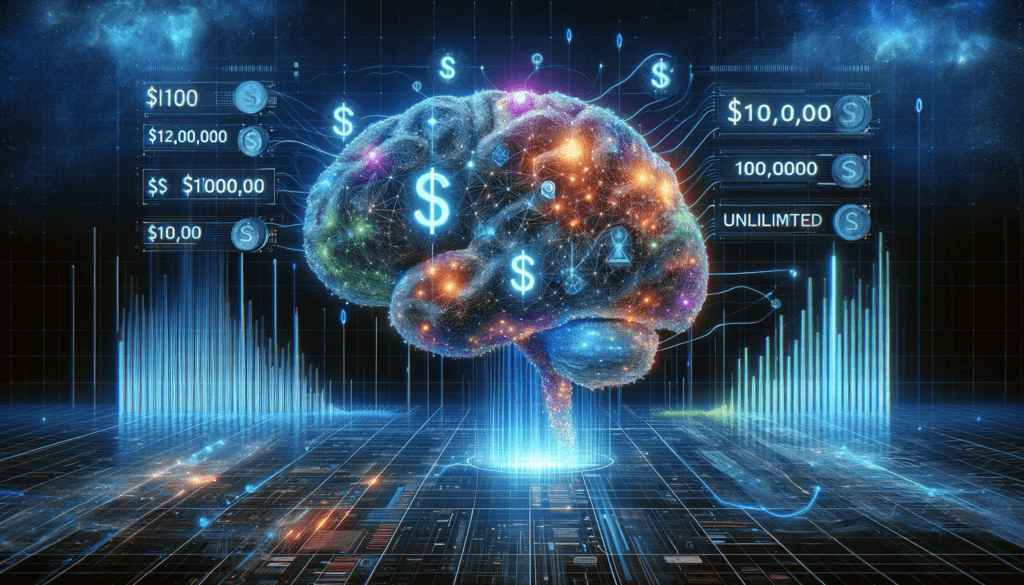As the business world increasingly embraces Artificial Intelligence (AI), financial commitments in AI systems have surged, with analysts predicting spending to have reached nearly $118 billion in 2022 and anticipating it to surpass $300 billion in the coming years.
Beyond these numbers, the potential to automate various business processes using AI across sectors – from healthcare to finance – underscores its growing significance.
This article delves into the financial, time, and resource investments required for AI integration, highlighting the often overlooked cost-effectiveness of hiring AI consultants and experts over building an in-house team.
Financial Investments
Custom AI Solutions
Custom AI services involve significant investment, ranging from $10,000 to over $500,000 and more.
The higher end of this spectrum typically encompasses solutions that require extensive customization to cater to specific business needs, such as complex data analysis systems or bespoke virtual assistants.
For businesses not requiring bespoke solutions, third-party software offers a more cost-effective route, ranging from free to $40,000 annually.
This variance largely depends on the software’s capabilities and the level of support provided.
For instance, rates for a custom-built chatbot start at $10,000, offering a relatively affordable entry point. However, more complex solutions like custom-built data analysis systems begin at $100,000, reflecting their increased sophistication and customization.
Hardware Investment
The efficiency of AI algorithms hinges on the capability of the underlying hardware.
This necessitates investment in high-performance computing resources, which are more costly than standard hardware.
According to Centerbase a “middle-of-the-road” server for AI can cost over $10,000, with an additional $2,000-plus for a backup system.
However, it’s important to note that as AI technology evolves, these hardware costs are expected to become more affordable, potentially lowering the barrier to AI adoption in the future.
Labor and Expertise Costs
Hiring a team of AI professionals, including data scientists, machine learning engineers, and software developers, represents a significant investment, often exceeding $100,000 per year per employee in the U.S.
This even get higher when accounting for additional expenses such as benefits, training, and office resources, pushing the annual cost for a small team well above $320,000.
Maintenance Costs
After deployment, the average production maintenance and support costs for an AI model are about 25% of the initial costs.
For example, if the initial development costs $1 million, the annual maintenance costs would be around $250,000.
Time Investments
Project Duration
The time frame for developing an AI solution is heavily influenced by its complexity and scope.
For example, a full AI analysis system can take up to or over a year to develop from conception to deployment.
In contrast, simpler AI projects, such as a basic chatbot or a minimum viable product (MVP) for a more complex system, can be developed within a shorter time frame of 4 to 6 months.
This variance in development time can significantly impact project timelines and resource allocation.
AI Model Training
The duration for training AI models is contingent on the size and complexity of the data sets.
Larger data sets require extended periods for processing and training, which can prolong the overall project timeline.
This factor is particularly relevant in cases where the AI solution involves complex data analysis or pattern recognition tasks.
Ongoing Maintenance
Post-deployment, AI systems require continuous monitoring, updating, and maintenance.
This includes regular software updates, algorithm tweaks, and data retraining to adapt to new information or changing conditions.
The time commitment for these activities can be considerable, especially for systems that are critical to business operations or those requiring frequent adjustments.
Understanding The ROI
ROI in AI development for businesses is about measuring how much value AI brings compared to what it costs.
It’s not just about how much money AI can save or earn for a company.
Sure, AI can speed up processes and reduce mistakes, which saves money, and it can boost sales by improving things like marketing. But there’s more to it.
AI can also give a business an edge over competitors and make customers happier, which is really valuable.
These benefits might not be easy to measure right away, but they play a big role in a business’s long-term success.
Conclusion
The integration of AI in business demands careful consideration of both financial and time resources.
While AI offers significant benefits, the investment required is not insignificant.
For many businesses, particularly smaller ones, the cost-effective and efficient route might be to hire an AI consulting company.
This approach can provide access to specialized expertise and technology without the overhead of an in-house team.
It allows businesses to leverage the advantages of AI while managing costs and focusing on their core operations.
In the dynamic and complex landscape of AI, such strategic collaborations could prove to be a wise decision.
Curious About The Above Solution?
Chat with Vejūnė and explore your possibilities without any commitment.


Vėjūnė Krašinskienė
Chief Operating Officer
Book a no-obligation free consultation with our expert.



